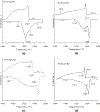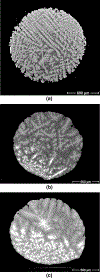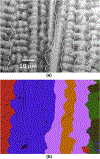Solidification of Ni-Re Peritectic Alloys
- PMID: 33061254
- PMCID: PMC7552818
Solidification of Ni-Re Peritectic Alloys
Abstract
Differential thermal analysis (DTA) and microstructural and microprobe measurements of DTA and as-cast Ni-Re alloys with compositions between 0.20 and 0.44 mass fraction Re provide information to resolve differences in previously published Ni-Re phase diagrams. This investigation determines that the peritectic invariant between liquid, Re-rich hexagonal close packed and Ni-rich face center cubic phases, L + HCP → FCC, occurs at 1561.1 °C ± 3.4 °C (1σ) with compositions of liquid, FCC and HCP phases of 0.283 ± 0.036, 0.436 ± 0.026, and 0.828 ± 0.037 mass fraction Re, respectively. Analysis of the microsegregation in FCC alloys yields a partition coefficient for solidification, k = 1.54 ± 0.09 (mass frac./mass frac.). A small deviation from Scheil behavior due to dendrite tip kinetics is documented in as-cast samples. No evidence of an intermetallic phase is observed.
Figures
















References
-
- Saunders N and Miodownik AP: CALPHAD (Calculation of Phase Diagrams): A Comprehensive Guide, Pergamon, Oxford, 1998.
-
- Maisel SB, Schindzielorz N, Mottura A, Reed RC, and Müller S: Phys. Rev. B, 2014, vol. 90, p. 094110.
-
- Elliott RP: Constitution of Binary Alloys, First Supplement, McGraw-Hill, New York, 1965, pp. 666–67.
-
- Pogodin SA and Skryabina MA: Izv. Sektora Fiz.-Khim. Analiza, Inst. Obshch. i Neorgan. Khim., Akad. Nauk. SSSR, 1954, vol. 25, pp. 81–88.
-
- Massalski TB: Binary Alloy Phase Diagrams, ASM International, Materials Park, 1990.
Grants and funding
LinkOut - more resources
Full Text Sources
Miscellaneous
